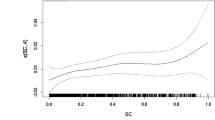Abstract
This article introduce two new characteristics of firms, which are important, from a macroeconomic view, to evaluate the roll of entrepreneurial tissue in the territorial economic growth: functional dependence and productive dependence. An empirical analysis has been formulated in order to contrast the importance of these entrepreneurial characteristics, and try to show its relation with territorial economic growth.

Similar content being viewed by others
References
Acs, Z. J. (1992). Small business economics: A global perspective. Challenge, 35, 38–44.
Aghion, P., & Howitt, P. (1992). A model of growth through creative destruction. Econometrica, 60, 323–351.
Alfonso Gil, J. (2002). Empresa e innovación en la Unión Europea. Madrid: Minerva Ediciones.
Audretsch, D., & Thurik, R. (2004). A model of the entrepreneurial economy. International Journal of Entrepreneurship Education, 2(2), 143–166.
Camagni, R. (1991). Local “milieu”, uncertainty and innovation networks: towards a new dynamic theory of economic space. In R. Camagni (Ed.), Innovation networks: Spatial perspectives. London: Belhaven.
Carre, M., & Thurik, R. (2003). The impact of entrepreneurship on economic growth. In D. B. Audretsch & Z. J. Acs (Eds.), Handbook of entrepreneurship research (pp. 437–471). Boston: Kluwer Academic Publishers.
Courlet, C., & Soulage, B. (1995). Dinámicas industriales y territorio. In A. Vázquez Barquero & G. Garofoli (Eds.), Desarrollo Económico Local en Europa. Madrid: Colegio de Economistas.
Capellin, R. (1991). The New Gravity Centers of Regional Development in the Europe of the 90′s. Barcelona: XX Reunión de Estudios Regionales.
Driffield, N., Munday, M., & Roberts, A. (2002). Foreign direct investment, transaction linkages, an the performance of the domestic sector. International Journal of the Economics of Business, 9, 335–351.
Drucker, P. (1985). Purposeful innovation and the seven sources for innovative opportunity. Innovation and entrepreneurship: Practice and principles. New York: Harper and Row.
Dubini, P. (1989). The influence of motivation and environment on business start-ups: Some hints for public policies. Journal of Business Venturing, 4(1), 11–26.
Fagerberg, J. (1988). International competitiveness. Economic Journal, 98, 335–374.
Feldman, M. P., & Audretsch, D. B. (1999). Innovation in cities: Science-based diversity, specialization and localized monopoly. European Economic Review, 43, 409–429.
Florio, M. (1996). Large firms, entrepreneurship and regional development policy: Growth poles in the Mezzogiorno over 40 years. Entrepreneurship and Regional Development, 8, 263–295.
Garofoli, G. (1994). Economic development, organization of production and territory. In G. Garofoli & A. Vázquez Barquero (Eds.), Organization of production and territory: Local models of development. Pavia: Universitá degli studi de Pavia.
Grabher, G. (1993). Rediscovering the social in the economic of interfirm relation. In G. Grabher (Ed.), The embedded firm. On socioeconomics of industrial networks. London: Routledge.
Grossman, G. M., & Helpman, E. (1991). Innovation and growth in the global economy. Cambridge: MIT.
Guzmán, J., & Cáceres, F. R. (2007). Entrepreneurial structure qualitative analysis: The case of Seville (Spain). International Advances in Economic Research, 13(4), 488–494.
Hewings, G. (1982). The empirical identification of key sectors in a economy: a regional perspective. Developing Economies, 20, 173–195.
Hewings, G., Merrifield, J., & Schneider, J. (1984). Regional tests of the linkage hypothesis. Revue d’Economie Regionale et Urbaine, 2, 275–289.
Hirschman, A. O. (1958). The strategy of economic development. New Haven: Yale University Press.
I.N.E. (2005). Directorio Central de Empresas 2005. Madrid: Instituto Nacional de Estadística.
Izhushi, H. (1999). Can a development agency foster cooperation among local firms? The case of Welsh Development Agency’s supplier association programme. Regional Studies, 33, 739–750.
Leontief, W. (1975). Análisis económico input-output. Barcelona: Ariel. First edition from 1966: Input-Output Economics. New York: Oxford University Press.
McCann, P. (1997). How deeply embedded is silicon glen? A cautionary note. Regional Studies, 31(7), 695–703.
McMillan, J., & Woodruff, C. (2002). The central role of entrepreneurs in transition economies. Journal of Economic Perspectives, 16(3), 153–272.
Midmore, P., Munday, M., & Roberts, A. (2006). Assessing industry linkages using regional input-output tables. Regional Studies, 40(3), 329–343.
Perroux, F. (1964). La economía del siglo XX. Barcelona: Ariel. First edition from 1961: L’Economie du XX Siecle. Presses Universitaries de France.
Pyke, F. (1994). Small firms, technical services and inter-firm cooperation. Research Series 99. Geneva: International Institute for Labour Studies.
Sarasvathy, S., Dew, N., Velamuri, S., & Venkataraman, S. (2003). Tree views of entrepreneurial opportunity. In Z. J. Acs & D. B. Audretsch (Eds.), Handbook of entrepreneurship research. An interdisciplinary survey and introduction. Boston: Kluwer Academic Publisher.
Schumpeter, J. A. (1976). Teoría del desenvolvimiento económico. México: Fondo de Cultura Económica. First edition in Germany, from 1911: Theorie der Wirtschaftlichen Entwicklung, Manchen: Verlag Dunker and Humbolt.
Schumpeter, J. A. (1983). Capitalismo, socialismo y democracia. Barcelona: Ediciones Orbis. First edition in English from 1942: Capitalism, Socialism and Democracy. New York: Harper and Row.
Shane, S. (2003). A general theory of entrepreneurship. Massachusetts: Edward Elgar Publishing.
Sonis, M., Guilhoto, J., Hewings, G., & Martins, E. (1995). Linkages, key sectors and structural change: Some new perspectives. Developing Economies, 23, 233–270.
Stewart, J. (1976). Linkages and foreign direct investment. Regional Studies, 10, 245–258.
Storey, D. J. (1984). Entrepreneurship and the new firm. Camberra: Croom Helm Ltd.
Storey, D. J. (1994). Understanding the Small business sector. London: Routledge.
Turok, I. (1997). Linkages in the Scottish electronics industry: Further evidence. Regional Studies, 31, 705–771.
Vázquez Barquero, A. (1999). Desarrollo, redes e innovación. Lecciones sobre desarrollo endógeno. Barcelona: Ariel.
Vespargen, B. (1992). Endogenous innovation in neo-classical growth models: A survey. Journal of Macroeconomics, 14, 631–662.
Wennekers, S., & Thurik, R. (1999). Linking entrepreneurship and economic growth. Small Business Economics, 13, 27–56.
Author information
Authors and Affiliations
Corresponding author
Rights and permissions
About this article
Cite this article
Cáceres-Carrasco, F.R., Guzmán-Cuevas, J. Functional and productive dependence: new characteristics for the analysis of enterprises from a macroeconomic view. Int Entrep Manag J 6, 117–130 (2010). https://doi.org/10.1007/s11365-010-0141-4
Published:
Issue Date:
DOI: https://doi.org/10.1007/s11365-010-0141-4




